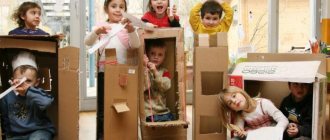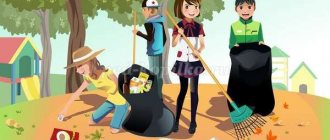“Long-term planning for cognitive and research activities”
« Long-term planning for cognitive and research activities"
The work provides long-term planning in the preparatory group for the year. The educational area is the natural world. The work is planned on the basis of methodological manuals by Bondarenko T.M. “Practical material. Cognition”, Voronkevich O.A. “Welcome to ecology!”
MBDOU "Kindergarten compensatory type No. 82"
G.Saratov
Educator.
(Preparatory group)
| Educational area | World of nature. | ||||
| September | 1 Week | 2 week | 3 week | 4 week | |
| Environmental education Conversation about summer. Goal: To deepen and generalize children’s ideas about summer and its typical features. To consolidate an understanding of the life activity of plants and animals, children’s games in summer, and the work and rest of adults. Learn to establish the simplest connections between environmental conditions and the state of living objects, express your thoughts in coherent speech Bondarenko T.M. “Practical material. Cognition" page 130 | Environmental education “What kinds of insects are there?” Goal: To systematize children’s ideas about the diversity of insects, to teach how to form groups on different grounds: To consolidate knowledge about the general characteristics of insects, to learn to establish connections between the features of the external structure and the method of movement, between the appearance and the method of protection from enemies, between the methods of movement and the habitat. Cultivate an interest in insects and a caring attitude towards them. Bondarenko T.M. “Practical material. Cognition" page 133 | Environmental education "Planet Earth is in danger" Purpose: To give children the idea that planet Earth is a huge ball. Most of the globe is covered with water - oceans and seas. In addition to water, there are continents - solid land - land where people live. Planet Earth is now in danger: in many places the water, soil, and air have become dirty. Everyone finds it difficult to breathe, people and animals get sick. To save our planet, we must love nature from childhood, study it, and communicate with it correctly. Bondarenko T.M. “Practical material. Cognition" page 135 | Environmental education “What is nature? Living and inanimate nature" Goal: To teach children to distinguish natural objects from artificial ones created by man, objects of living nature from objects of inanimate nature. To form in the child an idea of the inextricable connection between man and nature (man is part of nature). Introduce the main natural components and their connections. Bondarenko T.M. “Practical material. Cognition" page 139 | ||
| October | 1 Week | 2 week | 3 week | 4 week | |
| “Medicinal plants – means of healing the body” Develop cognitive activity, form an understanding of medicinal plants, the rules of their collection, storage and use. Develop research activities. Bondarenko T.M. “Practical material. Cognition" page 143 | "Excursion to the autumn forest" To form in children an idea of how plants prepare for autumn, to give knowledge about fruits and seeds. Find out about the living conditions of plants in autumn. Introduce adults to work in the park. Bondarenko T.M. “Practical material. Cognition” p.154 | "Reservoirs of Russia" Differentiate children's ideas about a body of water and its inhabitants. Develop environmental thinking in the process of research activities. Bondarenko T.M. “Practical material. Cognition" page 145 | “Why don’t polar bears live in the forest?” Introduce children to the polar bear and its way of life. Bondarenko T.M. “Practical material. Cognition" page 149 | ||
| November | 1 Week | 2 week | 3 week | 4 week | |
| Environmental education "Houseplants. Green Helpers" Expand and systematize children’s knowledge about indoor plants; about the benefits they bring to us; consolidate knowledge about the structure of plants, their care, and pests of indoor plants. Voronkevich O.A. “Welcome to ecology!” p.240 | Environmental education "Conversation about autumn" Goal: To summarize and systematize children’s knowledge about autumn. Learn to establish connections between the length of the day, air temperature and the condition of plants, the availability of food for animals and their adaptation to winter. Cultivate a caring attitude towards plants and animals. Bondarenko T.M. “Practical material. Cognition" page 163 | Environmental education "The Kingdom of the Snow Queen" To form children’s ideas about the climatic conditions of the Far North and the tundra; teach to establish connections between changes in living and inanimate nature; consolidate the idea of the adaptation of plants and animals to the conditions of the northern climate; develop the mental operation of comparison. Voronkevich O.A. “Welcome to ecology! Page 205 | Environmental education “What is beating there in your chest?” To provide basic knowledge about the most important human organ – the heart; that it is the support of our body. Cultivate curiosity and respect for your body . Voronkevich O.A. “Welcome to ecology!” (p.214) | ||
| December | 1 Week | 2 week | 3 week | 4 week | |
| Ecological upbringing . Conversation about the forest Goal: To clarify and expand children’s ideas about the forest, to consolidate children’s knowledge about trees and their various parts (roots, trunk, crown, etc.). Learn to distinguish oak from pine. Bondarenko T.M. “Practical material. Cognition" page 167 | Environmental education " Oak and pine" Goal: To give children an idea of the interconnections of living organisms. Tell that the life of some of them is connected with oak, the life of others with pine. Draw children's attention to the fact that each of the trees is associated with different organisms: plants, animals (and different birds, insects, animals), mushrooms. Talk about the possible consequences of cutting down individual trees and forests as a whole. Bondarenko T.M. “Practical material. Cognition". Cognition page 171 | Environmental education "The wolf and the fox are forest predators" Purpose: To clarify children’s ideas about the lifestyle of foxes and wolves in winter. To form an idea of the adaptability of predators to obtaining food: sensitive ears, keen eyesight, good sense of smell, endurance. To train children in the ability to compare and describe animals. Bondarenko T.M. “Practical material. Cognition" page 172 | Environmental education Conversation “Who is the boss in the forest?” Target: Give children an idea of a forester - a person who takes care of the forest. Help children develop the skills to behave wisely in the forest. Bondarenko T.M. “Practical material. Cognition" page 180 | ||
| January | 1 Week | 2 week | 3 week | 4 week | |
| Environmental education “Fire is a friend, fire is an enemy!” Introduce children to fire as a phenomenon of inanimate nature; show the need for fire as a condition of life on Earth; show the inconsistency of this phenomenon (brings life and death); introduce the history of human use of fire; activate your vocabulary. Voronkevich.O.A. “Welcome to ecology!” (p.208) | Environmental education . "Comparison of wild and domestic animals" Clarify with your children the signs of pets. Show that they are different from wild ones. Exercise children's mental abilities. Bondarenko T.M. “Practical material. Cognition" page 185 | Environmental education "I am human" Based on research activities, develop the idea that man is a part of nature, and at the same time a thinking being; improve children's speech, develop imagination, creative imagination, communicative communication. Bondarenko T.M. “Practical material. Cognition” p.183 | |||
| February | 1 Week | 2 week | 3 week | 4 week | |
| Environmental education “Feed the birds in winter...” Summarize children's knowledge gained from bird watching; establish connections between the shape of the beak and the nutrition of birds; note the relationships between birds during wintering; make us want to help our winged friends during the winter lack of food. Voronkevich O.A. “Welcome to ecology!” (p.200) | Environmental education " A story about ecological pyramids" Goal: To form in children an idea of the relationship between the inhabitants of the forest - plants and animals, their food dependence on each other Bondarenko T.M. “Practical material. Cognition" page 190 | Environmental education « Bactrian camel of the desert" To deepen children's understanding of the diversity of living creatures that inhabit our planet, introduce them to a desert inhabitant - the camel, and tell how it has adapted to living conditions. Develop children's cognitive activity and creative imagination. Bondarenko T.M. “Practical material. Cognition" page 192 | Environmental education “How a squirrel, a hare and a moose spend the winter in the forest” To form in children an idea of the life of animals in the forest, their adaptation to the winter period. Bondarenko T.M. “Practical material. Cognition" page 195 | ||
| March | 1 Week | 2 week | 3 week | 4 week | |
| Environmental education Conversation “Forest as an ecological system” Purpose: to introduce trees, shrubs, herbs; expand vocabulary; develop memory and attention. Source: Voronkevich O.A. “Welcome to ecology!” , pp. 9-11 | Environmental education Conversation “The Secret Pages of the Forest...” Purpose: to talk about signs in the forest, about methods of orientation. Didactic game “Compass” Source: Voronkevich O.A. “Welcome to ecology!” ,With. 28-30 | Environmental education Project “Ecocity”. Goal: to concretize children’s knowledge about environmental factors for life in nature and in the city; to develop imagination and creativity; cultivate the ability to predict the consequences of their actions, the desire to live in a clean city. Source: Voronkevich O.A. “Welcome to ecology!” ,With. 38-43 | Environmental education Project “Ecocity”. Goal: to concretize children’s knowledge about environmental factors for life in nature and in the city; develop imagination and creativity; cultivate the ability to predict the consequences of their actions, the desire to live in a clean city. Source: O.A. Voronkevich “Welcome to ecology!” ,With. 38-43 | ||
| April | 1 Week | 2 week | 3 week | 4 week | |
| Environmental education Mini-project “The Earth is our common home.” Goal: to instill a sense of responsibility, respect for nature; to cultivate a sense of unity and harmony with nature. Source: Adji A.V., “Notes of integrated classes”, p. 202-205 | Environmental education Mini-project “The Earth is our common home.” Goal: to instill a sense of responsibility, respect for nature; to cultivate a sense of unity and harmony with nature. Source: Adzhi A.V., “Notes of integrated classes”, p. 202-205 | Environmental education Experiment-observation “Chestnut branch” Goal: to cultivate a caring attitude towards nature, to teach how to receive aesthetic pleasure from communicating with nature. | Environmental education Experiment-observation “Chestnut branch” Goal: to cultivate a caring attitude towards nature, to teach how to receive aesthetic pleasure from communicating with nature. | ||
| May | 1 Week | 2 week | 3 week | 4 week | |
| Environmental education Project “Ecocity” (continued) “What kind of city do people need?” Goal: to summarize children’s ideas about what kind of city people need. Voronkevich O.A. “Welcome to ecology!” p.42. | Environmental education Project “Ecocity” (continued) “How to make the air in the city clean and fresh?” Goal: to summarize children’s ideas about what kind of city people need. Voronkevich O.A. “Welcome to ecology!” p.44 | Environmental education "Live nature. Evolution. Diversity of living organisms" Source: O.V. Dybina “The unknown is nearby Experiences and experiments for preschool children” Moscow, 2011, p. 135 | Environmental education " Inanimate nature. Water and air" Source: O.V. Dybina “The unknown is nearby Experiences and experiments for preschool children” Moscow, 2011, p. 143 | ||
Literature:
1. Bondarenko T.M. “Practical material. Cognition",
2. Voronkevich O.A. “Welcome to ecology!”
3. Dybina O.V. “The unknown is nearby Experiences and experiments for preschoolers” Moscow, 2011.
4. Adzhi A.V., “Notes of integrated classes.”
Downloaded from www.znanio.ru

